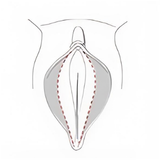Labia Reduction
Labiaplasty
Labiaplasty, or labia reduction, is a term that encompasses a number of procedures targeted at the labia minora and majora, also known as the inner and outer “lips” that surround the clitoris and vaginal opening. Labiaplasty aims to correct a number of conditions, including enlarged, asymmetric, abnormally shaped or discoloured labia. Most procedures take up to an hour and a half and are performed on an outpatient basis.
Who is a Good Candidate for a Labiaplasty?
Many women undergo labiaplasties for aesthetic reasons; they are unhappy with or embarrassed by their enlarged or misshapen labia. Labia hypertrophy, or enlarged labia, is a condition that can occur naturally with age, childbirth, injury, hormonal changes, or chronic irritation, and can be mild or severe. Some women are genetically predisposed to having larger labia. A woman’s labia minora may become asymmetrical, enlarged or elongated, and may protrude past the labia majora, leading to a “saggy” appearance. Many women are self-conscious about their enlarged labia in intimate situations, which can lead to sexual dissatisfaction. For women with severe labia hypertrophy, the labia can appear as a “bulge” when they wear swimwear or other tight clothing.
Labiaplasty Aesthetic Styles
There is no single “labiaplasty” procedure, but rather various types of procedures that target the labia structures. The techniques used depend on the desired final result. Some labiaplasty procedures include:

The “Barbie” or “Smooth” Labiaplasty
This style removes most or all of the labia minora, leaving a smooth, tucked-in appearance that resembles the look of a doll. It is ideal for those who prefer a minimal or completely concealed inner labia.

The “Rim” or “Peek-A-Boo” Labiaplasty
A subtle reduction that preserves some of the labia minora while still creating a neat, refined appearance. This style allows for a slight natural contour, giving a balanced and symmetrical look.

The Hybrid Labiaplasty

Labia Majoraplasty
This procedure focuses on the labia majora (outer vaginal lips), removing excess skin and wrinkles for a smoother, firmer look. It’s ideal for women who experience sagging due to aging or childbirth, which can make the area appear loose.
For mild sagging, labia puffing—using fat transfer or dermal fillers—can restore volume and create a tighter appearance. This non-surgical option can be done alone or alongside skin removal for enhanced results.
Labiaplasty Techniques
These refer to the surgical methods used to reshape or reduce the labia minora or majora.

Trim Technique
The excess labial tissue is trimmed along the edge to create a smaller, neater appearance.

Wedge Technique
A V-shaped wedge is removed from the central labia, preserving the natural border for a seamless look.

De-epithelialization Technique
Excess tissue is removed while maintaining the natural contours of the labia.
Combined Procedures for Vaginal Rejuvenation
Labiaplasty & Vaginal Tightening
Labiaplasty is often performed simultaneously with vaginal tightening procedures, as well as a number of other intimate procedures that target the genital area. Combining intimate procedures is advisable as, while it may lengthen recovery time, it puts much less stress on the body than two separate surgeries, and reduces costs associated with anaesthesia and the use of surgical facilities. Price adjustments are usually available for patients undertaking multiple procedures.
Labiaplasty Recovery
For women who are tired of the pinching and irritation caused by labia hypertrophy, or for those who are simply unsatisfied with the appearance of their intimate area, labiaplasty could be an effective solution.
Have Your Procedure Now, Pay Later
Labiaplasty starts at $4,800 (Local Anesthesia) and $5,500 (General Anesthesia) – Flexible financing available! We make it easy—fast approvals and budget-friendly financing plans!
Your Transformation Starts Here!
Book Your Consultation Today
Call 416-360-7-360 or fill out the form below—we’ll guide you every step of the way!

